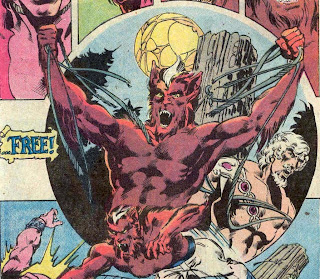Time to re-enter the lost world with another installment of my issue by issue examination of DC Comic's Warlord
, the earlier installments of which can be found here...
"Hunter's Moon"
Warlord (vol. 1) #47 (July 1981)
Writing and art by Mike Grell; inks by Bob Smith
Synopsis: In the darkness of the Terminator, where the inner world of Skartaris folds back upon the outer Earth, Jennifer Morgan sleeps peacefully, unaware that she is in the castle of Deimos, her father’s greatest enemy.
She’s also unaware that there's a man standing above her with a dagger.
The cowled man who has been her guide hesitates. She may be the daughter of his masters greatest foe, but he can’t bring himself to harm her. Instead, he cuts his own hand, and lets the blood flow into a goblet. He opens the mysterious wooden box he carries, and proffers the cup: “I have done as you command, Master. Take this and drink deep!”
Elsewhere in the Terminator, Shakira and Morgan have been making camp to rest from their travels, when they’re suprised by a strange sight in the sky. Skartaris apparently has a moon! Morgan dashes off a fairly dubious theory:
Morgan decides to go hunting by moonlight, while Shakira catches a nap. Morgan finds a pond where animals are watering. He stalks up and pounces on an ibex-looking beast with his knife.
The moon sinks below the trees as Morgan makes his way back to camp. A dead body and the sound of battle diverts him from his path. Morgan runs toward the clamor with sword drawn, finding more bodies along the way. Finally, he comes upon a clearing where a man dressed like he’s from the upper world is engaged in battle against a group of savage foes.
Morgan admires the man’s skill for a moment before joining the battle at his side. Together, they quickly slay all their foes.
Morgan introduces himself, and the man--after getting over his suprise that Morgan speaks English--responds, in a Russian accent, that his name is Mikola Rostov. Then he demands to know where Mariah Romanov is. Rostov explains that he was Mariah’s fencing instructor--and more. He found out about Skartaris from the ever-helpful Professor Lakely. Morgan assures Rostov that he’s a friend of Mariah’s too, and he will be glad to tell him what happened to her.
Morgan makes a fire and cooks some of his kill. Rostov declines to join him in the meal, saying he has already eaten, and asks Morgan to go on with his story. Morgan tells him about the meteorite that sent Machiste and Mariah back to the past. Rostov’s skeptical about magic, but Morgan tells him it works, whatever it is.
After eating, Morgan drowses, and Rostov sneaks off into the forest to go on a hunt of his own. When he returns to camp, Morgan is awake and wondering where he’s been all this time. He tells Morgan he’s been hunting, but the explanation isn’t satisfactory because they have plenty of meat. Morgan also notices that Rostov looks larger now, more muscular.
Before Morgan can speculate any further, the tribesmen of the savages they killed drop a net on the two from above. They’re caught, and soon they’re tied to a post over the makings a fire. Morgan suspects the tribesmen intend to eat them--which is sort of an honor, given the cultural beliefs he attributes to the tribe.
Rostov is barely hearing Morgan’s explanation. He’s transfixed by the returning moon. Before Morgan;s eyes, Rostov transforms--into a werewolf:
Rostov bursts their bonds then savagely rips into the tribesmen. When he’s done with them, he turns on Morgan--who now has his gun and pistol drawn.
At that moment, the moon passes away, taking Rostov’s wolf-form with it, though it leaves him larger and more bestial-looking than before. He explains to Morgan that he suffers from the curse of lycanthropy. He came to Skartaris thinking the eternal sun would free him, but the strange wanderings of the ever-present moon has caused him to take on more wolf characteristics in his human form. He admits that Morgan chose the wrong side in helping him--it was he who attack the tribesman.
Rostov plans to continue his search for Mariah--and perhaps in this land of magic there may yet be a cure for his curse. Rostov runs off into the woods, as he again feels the pull of the returning moon.
Things to Notice: - Despite having been to the Terminator before, neither Morgan nor Shakira have never seen or heard of the wandering moon.
- Shakira sleeps (apparently) through the whole issue.
Where It Comes From:
The title of this issues derives from the
hunter's moon (also known as the blood moon--which is the title of a
previous issue about a moon-like object), which is the first full moon after the harvest moon, which is, in turn, the first full moon after the autumnal equinox. In the northern hemisphere it usually comes in October.
"
Rostov" is a Russian placename. The town bearing that name is better known to Russians as Rostov Veliky ("Rostov the Great"). It's one of the oldest towns in Russia.


















